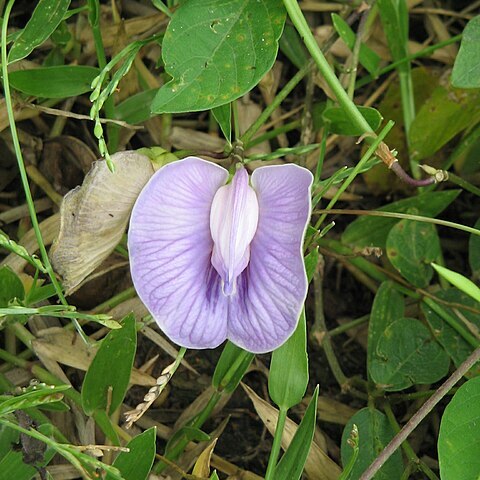Herbs or subshrubs, climbing or prostrate. Leaves pinnately (1–)3(–7)-foliolate, rarely digitately 3–5-foliolate; stipules not spurred, persistent; stipels present. Inflorescences axillary, falsely racemose, (1–)few-many-flowered; rhachis often thickened at the insertion of the pedicels; bracts paired, mostly persistent, striate, those towards the apex of the inflorescence united; bracteoles adpressed to the calyx, striate. Calyx 5-lobed, the upper pair of lobes united to form an emarginate or bifid lip. Standard rounded, spurred or rarely with a tubercle on the back above the claw. Vexillary stamen free or ± joined with the others; anthers uniform. Ovary linear, many-ovuled; style bent, compressed towards the summit, spathulate, pubescent or bearded at the apex, stigma terminal. Pods linear, compressed, with 4 raised nerves or wings, filled between the seeds. Seeds oblong or globose, compressed; hilum linear, oblong or narrowly elliptic; aril small or absent.
Shrubs or herbs, procumbent or climbing. Leaves pinnately 3(-7)-foliolate; stipules striate, basifixed, persistent; stipels small. Inflorescence axillary, clustered to racemose, 1-to many flowered; bracts similar in shape to stipules; bracteoles 2, adnate to calyx, persistent, striate, larger than bracts. Calyx shortly campanulate, 5-lobed; lobes unequal. Corolla white, purple, red, or blue, longer than calyx; standard ± circular, abaxially hairy, base clawed, with short abaxial spur above claw. Stamens diadelphous; vexillary stamen free; anthers uniform. Ovary sessile; ovules many; style compressed, spatulate at apex, pubescent or bearded at apex; stigma terminal. Legume linear, dehiscent, compressed, filled between seeds. Seeds to 20, oblong or globose; hilum linear to narrowly elliptic; strophiole small or absent.
Fls resupinate, the banner lowermost; cal nearly regular, the tube hemispheric, the lobes subequal; standard rotund, much exceeding the other pet, with a minute median spur at the base; wings oblong, obtuse; keel-pet broadly semi-obovate, strongly incurved; stamens 10, diadelphous, the anthers all alike; style glabrous, strongly incurved to the pilose stigma; fr elongate, many-seeded, with a longitudinal ridge near each margin, tightly coiled after dehiscence; twining herbs with pinnately compound lvs of 3 stipellate lfls, and with solitary or clustered axillary fls. 45, New World.
Ovary linear, many-ovuled; style curved, flattened and slightly widened towards the terminal stigma, pubescent or bearded at the apex.
Leaves pinnately 3-foliolate in the Flora Zambesiaca area, elsewhere (1)3(7)-foliolate; stipules small, striate; stipels present.
Inflorescences (1)few–many-flowered, falsely racemose; bracts paired, striate; bracteoles appressed to the calyx, striate.
Corolla showy; standard broad, with a conspicuous spur on the back above the claw, often pubescent outside.
Seeds variously coloured, oblong or ellipsoid, with an elliptic to linear hilum.
Calyx 5-lobed, the upper pair largely joined into a bifid lip.
Vexillary filament free or joined to the others at the base.
Pod linear, with 4 raised nerves or wings, dehiscent.
Climbing herbs or subshrubs.


